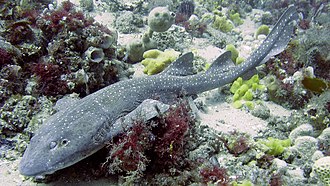Difference between revisions of "AY Honors/Species Account/Brachaelurus waddi/es"
From Pathfinder Wiki
< AY HonorsAY Honors/Species Account/Brachaelurus waddi/es
(Created page with "Libro de Respuestas de Especialidades JA/Cuenta de Especie/Brachaelurus waddi") |
(Created page with "</noinclude> {{species id/es |common_name=Tiburón ciego |latin_name=Brachaelurus waddi |image=Blindshark.jpg |description= El ciego tiburón en realidad NO está ciego. Recib...") |
||
| Line 1: | Line 1: | ||
<noinclude></noinclude> | <noinclude></noinclude> | ||
| − | {{species id | + | {{species id/es |
| − | |common_name= | + | |common_name=Tiburón ciego |
|latin_name=Brachaelurus waddi | |latin_name=Brachaelurus waddi | ||
|image=Blindshark.jpg | |image=Blindshark.jpg | ||
|description= | |description= | ||
| + | El ciego tiburón en realidad NO está ciego. Recibió su nombre por la costumbre de cerrar sus ojos cuando se saca del agua. Menos de 62-66 cm (24-26 pulgadas) de largo, el tiburón ciego tiene un robusto, de color grisáceo a marrón cuerpo con manchas blancas y bandas oscuras que se desvanecen con la edad. Su cabeza es ancha, aplanada y contundente, con pequeños ojos en la parte superior y un par de barbillas largas debajo. Cuenta con grandes aletas pectorales, dos aletas dorsales casi de igual tamaño colocadas muy atrás en el cuerpo, y una aleta anal colocado cerca de la aleta caudal. Este pequeño tiburón se adapta fácilmente a ser mantenidos en cautiverio, aunque la cría en el Acuario de Sydney. [video https://www.youtube.com/watch?v=nqzl2PvPMGc Corto Ciegos Shark] | ||
| + | |||
The Blind Shark is actually NOT blind, getting its common name came from the habit of closing its eyes when taken out of the water. under 62–66 cm (24–26 in) long, the blind shark has a stocky, grayish to brownish body with white flecks and darker bands that fade with age. Its head is wide, flattened, and blunt, with small eyes on top and a pair of long barbels underneath. It has large pectoral fins, two nearly equal-sized dorsal fins placed far back on the body, and an anal fin placed close to the caudal fin. This small shark adapts readily to being kept in captivity, even breeding in the Sydney Aquarium. [https://www.youtube.com/watch?v=nqzl2PvPMGc Short Blind Shark video] | The Blind Shark is actually NOT blind, getting its common name came from the habit of closing its eyes when taken out of the water. under 62–66 cm (24–26 in) long, the blind shark has a stocky, grayish to brownish body with white flecks and darker bands that fade with age. Its head is wide, flattened, and blunt, with small eyes on top and a pair of long barbels underneath. It has large pectoral fins, two nearly equal-sized dorsal fins placed far back on the body, and an anal fin placed close to the caudal fin. This small shark adapts readily to being kept in captivity, even breeding in the Sydney Aquarium. [https://www.youtube.com/watch?v=nqzl2PvPMGc Short Blind Shark video] | ||
|range=Eastern coast of Australia (from Mooloolaba in southern Queensland to Jervis Bay in New South Wales), this nocturnal, bottom-dwelling species is common in rocky areas and seagrass beds from the intertidal zone to a depth of 140 m (460 ft). It often roams in tidal pools where it may be trapped by the receding tide, and can survive for up to 18 hours out of water!}} | |range=Eastern coast of Australia (from Mooloolaba in southern Queensland to Jervis Bay in New South Wales), this nocturnal, bottom-dwelling species is common in rocky areas and seagrass beds from the intertidal zone to a depth of 140 m (460 ft). It often roams in tidal pools where it may be trapped by the receding tide, and can survive for up to 18 hours out of water!}} | ||
<noinclude></noinclude> | <noinclude></noinclude> | ||
Revision as of 16:03, 30 November 2015
| Brachaelurus waddi (Tiburón ciego) | |
|---|---|
|
Dónde se encuentra : Eastern coast of Australia (from Mooloolaba in southern Queensland to Jervis Bay in New South Wales), this nocturnal, bottom-dwelling species is common in rocky areas and seagrass beds from the intertidal zone to a depth of 140 m (460 ft). It often roams in tidal pools where it may be trapped by the receding tide, and can survive for up to 18 hours out of water!
Descripción: El ciego tiburón en realidad NO está ciego. Recibió su nombre por la costumbre de cerrar sus ojos cuando se saca del agua. Menos de 62-66 cm (24-26 pulgadas) de largo, el tiburón ciego tiene un robusto, de color grisáceo a marrón cuerpo con manchas blancas y bandas oscuras que se desvanecen con la edad. Su cabeza es ancha, aplanada y contundente, con pequeños ojos en la parte superior y un par de barbillas largas debajo. Cuenta con grandes aletas pectorales, dos aletas dorsales casi de igual tamaño colocadas muy atrás en el cuerpo, y una aleta anal colocado cerca de la aleta caudal. Este pequeño tiburón se adapta fácilmente a ser mantenidos en cautiverio, aunque la cría en el Acuario de Sydney. [video https://www.youtube.com/watch?v=nqzl2PvPMGc Corto Ciegos Shark]
The Blind Shark is actually NOT blind, getting its common name came from the habit of closing its eyes when taken out of the water. under 62–66 cm (24–26 in) long, the blind shark has a stocky, grayish to brownish body with white flecks and darker bands that fade with age. Its head is wide, flattened, and blunt, with small eyes on top and a pair of long barbels underneath. It has large pectoral fins, two nearly equal-sized dorsal fins placed far back on the body, and an anal fin placed close to the caudal fin. This small shark adapts readily to being kept in captivity, even breeding in the Sydney Aquarium. Short Blind Shark video
|
Brachaelurus waddi
|

